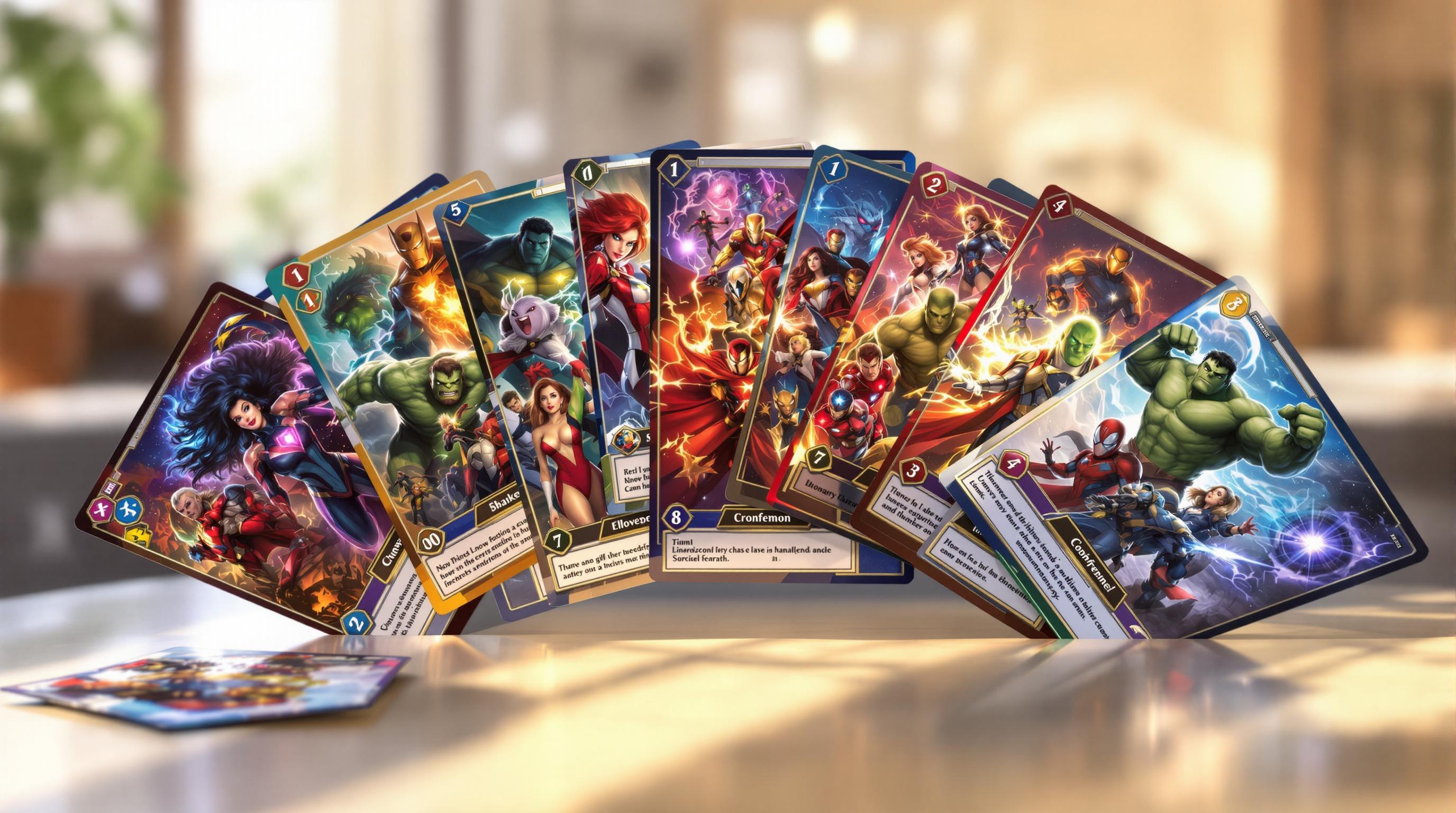The esports-driven card game market is booming, blending the nostalgia of physical cards with the excitement of digital competition. Here's what you need to know:
- Market Growth: The trading card game market is set to reach $6.6 billion in 2024, growing at 8.8% annually. The digital segment is expanding even faster at 12.18% annually, projected to hit $1.87 billion by 2032.
- Regional Leaders: North America leads with 40% of global revenue, followed by Europe at 30%. Asia Pacific is the fastest-growing region, with a 10.8% growth rate.
- Digital Evolution: Platforms like Magic: The Gathering Arena and Hearthstone are driving esports integration, while NFTs add unique ownership and trading opportunities.
- Hybrid Models: Physical stores and digital platforms now work together, connecting local communities with global players through services like Card Shops List.
The card game market's success lies in combining physical and digital experiences, appealing to casual collectors and competitive players alike. As esports and technology continue to evolve, this industry is poised for sustained growth.
1. Esports-Related Card Games
Market Growth
The trading card game market is expected to hit USD 6,614.2 million in 2024, with an annual growth rate of 8.80% through 2031. The digital segment is growing even faster, clocking in at 12.18% annually. When it comes to regions, North America leads with a 7% growth rate, followed by Europe at 7.3%. The Asia Pacific region, however, is setting the pace with a strong 10.8% growth, driven by rising interest in emerging markets. This upward trend is fueled by advancements in technology and a continuously expanding player base.
Player Demographics
Esports card games attract players across various age groups, but they see particularly high engagement among teens and young adults. In Europe and North America, there’s a noticeable push toward making these games more beginner-friendly, ensuring accessibility for newcomers while still offering complexity for seasoned players.
Digital Transformation
Digital platforms are reshaping the way players engage with card games, thanks to technologies like blockchain and NFTs. A great example is Loco's 2022 launch, which merged esports fantasy gaming with digital collectibles. These innovations are creating new ways for players to own and trade cards, blending traditional and digital gaming experiences and broadening the market.
| Platform | Features | Impact |
|---|---|---|
| Traditional Digital | Cross-platform play, rankings | Still dominates revenue |
| NFT-Based | Ownership, trading | A growing segment |
| Hybrid | Physical-digital mix | Gaining popularity |
Accessibility
Both physical and digital platforms play a key role in expanding the appeal of esports card games. Titles like Magic: The Gathering, Pokémon, and Yu-Gi-Oh continue to thrive by leveraging traditional card shops alongside digital platforms. This dual approach not only strengthens local communities but also connects players globally, making the games more accessible and engaging for a wide audience.
2. Established Card Game Marketplaces (e.g., Card Shops List)

Market Growth
Established marketplaces play a key role in keeping the trading card game market thriving by catering to both physical and digital preferences. North America leads the way, contributing around 40% of global revenue, thanks to games like Magic: The Gathering and Pokémon. These marketplaces serve a wide audience, from casual collectors to competitive players, fueling growth across the board.
Player Demographics
These marketplaces thrive by appealing to a variety of players. They offer services like trading, grading, and hosting community events, which attract both casual fans and serious competitors. Platforms like Card Shops List connect collectors with specialized stores that provide essential services, bridging the gap between physical and digital trading card game needs.
| Service Type | Traditional Shops | Digital Platforms |
|---|---|---|
| Trading | Face-to-face exchanges | Online marketplaces |
| Grading | Professional in-store evaluation | Digital certification services |
| Events | Local tournaments | Virtual competitions |
| Community | In-person gatherings | Online forums and groups |
Digital Transformation
Card shops listed on platforms like Card Shops List are adopting digital tools to stay relevant. Many traditional shops now offer online inventory systems and virtual trading platforms, blending physical and digital services. These updates make trading card games more accessible and help connect physical collectors with online communities.
Accessibility
These marketplaces have made trading card games more accessible by using a mix of physical stores and digital platforms. Physical stores remain essential for those who enjoy in-person experiences, while digital platforms cater to players seeking convenience. In North America, the market is expected to grow to USD 10,889.5 million by 2032, showing the strength of this multi-channel approach. Card Shops List exemplifies this strategy, linking players to stores that combine both physical and digital services to meet a wide range of needs.
Are All These New Trading Card Games Doomed To Fail?
sbb-itb-0db97a5
Strengths and Weaknesses
The esports-focused card game market has its share of advantages and challenges, shaping its current landscape and future potential. North America stands out as a strong performer, heavily influencing the industry's overall trends.
| Aspect | Strengths | Weaknesses |
|---|---|---|
| Market Performance | • Steady growth at 8.80% CAGR, with a forecasted USD 10,889.5M by 2032 | • Intense competition and heavy reliance on continuous innovation |
| Digital Integration | • Cross-platform gameplay boosts engagement | • High adaptation costs for traditional retailers |
| Player Base | • Broad demographic appeal and active competitive scene | • Difficulty in retaining players with varying interests |
| Distribution Channels | • Accessible through multiple channels with integrated services | • Challenges in inventory management and fragmented markets |
The shift toward digital platforms brings both opportunities and obstacles. For instance, the digital collectible card game sector is expected to grow at a CAGR of 12.18% through 2032, highlighting its potential. However, this shift also poses challenges for traditional retailers who must adapt to new digital trends.
Physical stores, such as those listed in Card Shops List, are rethinking their strategies to blend traditional collecting with modern innovations. Success in this market increasingly hinges on merging digital tools with the classic appeal of physical cards, catering to both casual collectors and competitive players.
The growing integration of physical and digital platforms reflects the influence of esports on the card game industry. Traditional retail spaces are evolving to meet the needs of competitive gaming while still appealing to their core audience. Striking this balance is critical as the market grows and diversifies.
Recognizing these strengths and weaknesses is key to navigating the fast-changing dynamics of the esports-driven card game market, where traditional and digital platforms continue to intersect.
Conclusion
The esports-driven card game market is showing strong growth potential, fueled by the expanding global esports industry. With esports revenue expected to hit $1.9 billion in 2024 (growing at a 16.0% CAGR), and digital platforms like Magic: The Gathering Arena and Hearthstone pushing the digital card game segment to a projected $1,873.02 million by 2032, the industry is evolving rapidly. This shift has blended traditional card collecting with competitive esports, creating a unique space for both casual and competitive players.
Player demographics are a key driver of this growth. From collectors to hardcore gamers, digital collectible card games are successfully uniting these audiences. Platforms are effectively bridging the gap between the nostalgia of physical card games and the excitement of esports competition.
Hybrid business models are also reshaping the landscape. Retailers and online marketplaces are combining physical and digital offerings, becoming essential meeting points for players and collectors alike. These spaces are thriving hubs for major franchises such as Pokémon, Magic: The Gathering, and Yu-Gi-Oh!.
Looking ahead, advancements like NFTs and cross-platform gaming are set to play a major role in shaping the future of card gaming in esports. The industry's ability to balance the appeal of traditional card collecting with the adrenaline of competitive gaming positions it for sustained growth. As technology and player preferences evolve, the card game market is poised to explore new opportunities within the ever-changing esports world.
FAQs
How big is the digital collectible card game market?
The digital collectible card game market is on a growth path, expected to hit USD 1,873.02 million by 2032, with a CAGR of 12.18%. Several factors are driving this growth:
| Growth Driver | Impact |
|---|---|
| Esports Integration | Builds competitive spaces that draw in global players and audiences. |
| Digital Platforms & Cross-Platform Play | Boosts accessibility and keeps players engaged. |
| NFT Integration | Allows for unique card ownership and trading opportunities. |
The market appeals to a wide audience - from adults drawn by nostalgia for classic franchises to younger gamers interested in esports and digital advancements. Top franchises continue to dominate, shaping the competitive and casual gaming scene.
This growth underscores how esports is reshaping card gaming, blending traditional collecting with the excitement of digital competition.


